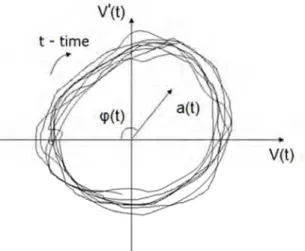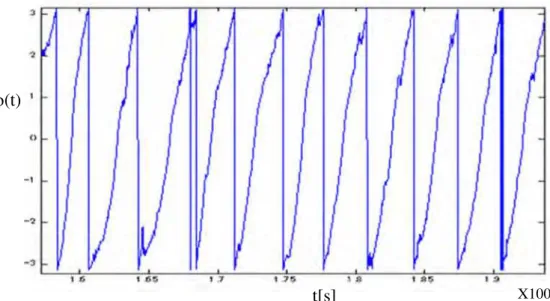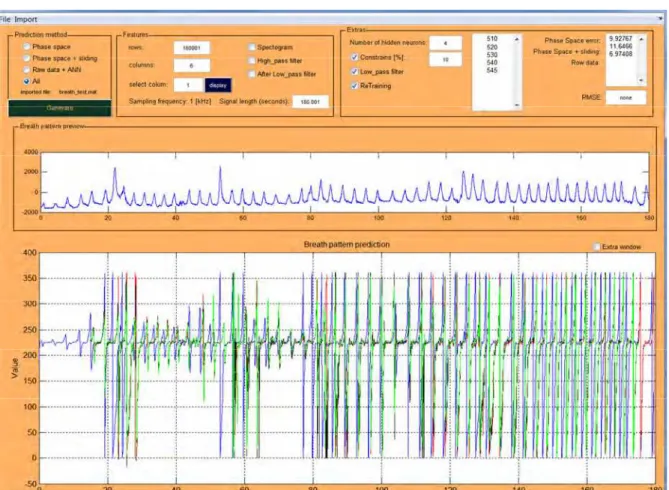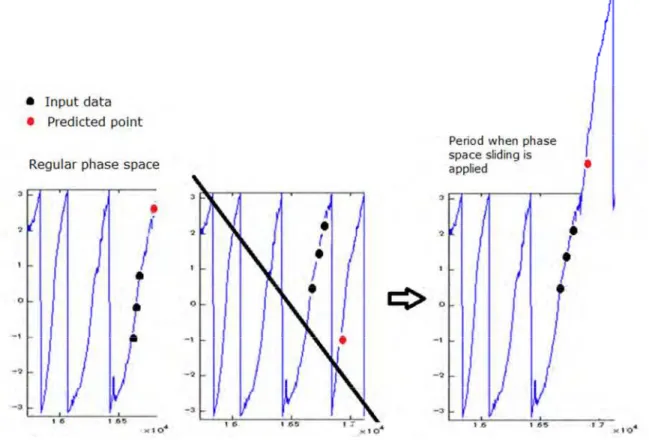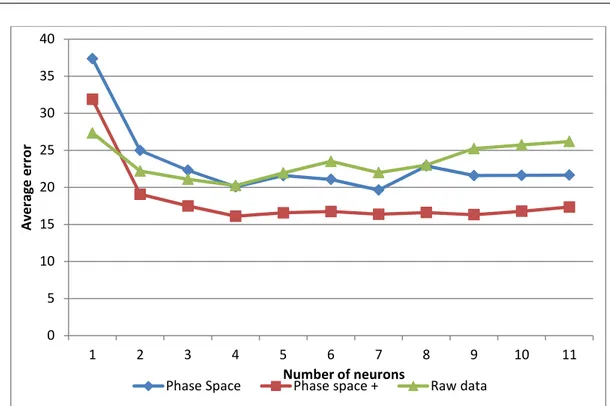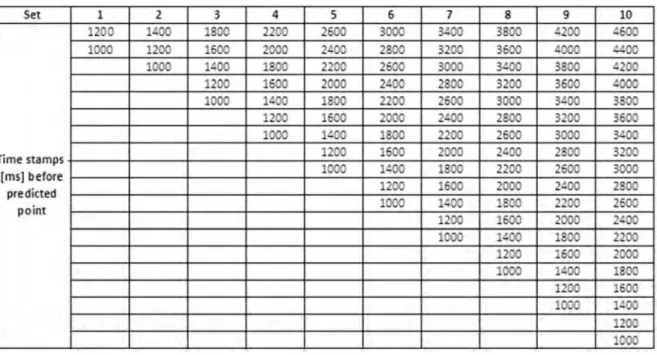Abstract: In this paper, a new approach of signal processing for breath prediction pattern recogni-tion is proposed and further analyses are presented. In order to extract key values from raw data, a shift from time domain to phase space has been utilized. It helped to achieve clearer peak-to-peak measurements which are crucial for breath prediction pattern recognition. Based on a special software tool for breath prediction pattern recognition several different algorithms have been compared. As a result, a reduction in error rate can be achieved when applying a new signal processing approach in comparison to the previous designs.
Keywords: pattern recognition, signal processing, neural network
1. Introduction
Breath is a part of human activity. Simultaneously with movement, skin tension, eye re-action, heartbeat, blood pleasure and other parameters describing our bodies’ state, we brea-the. Breath can describe our feelings, happiness, fear, anxiousness or relax. Thus, being able to predict breath pattern equals to being able to predict our near-future behavior according to current state and changes in error rate of breath prediction [4][5]. On the other hand it’s possible to track changes in our current state according to past behavior. For example, when we are calm and suddenly something disturbs us, the error rate between predicting signal and current state rises. Moreover, when a person listens to music, this kind of tracking changes, in his breath pattern, can be useful to alter main pitch in order to make him feel relaxed. Several similar researches have been conducted to predict cardiovascular symp-toms [1]. As stated in [2][3] breath can be tracked and measured by respiratory motion and local regressions method. However, these analyses are done completely in time domain, taking into consideration only raw data without any further transformations.
Figure 1. Signal V(t) in a phase space V’(t), where ϕ(t) is an angle in t-moment
2. Methodology
The respiration signals V(t) were collected during research and represented as a move-ment of chest position in time. First of all, by applying a phase space to a respiration signal a part of useless data can be reduced and also noises. However, peak-to-peak distances are preserved and underlined. It’s clear when a full breath takes place and a signal in a phase space moves from 360 degrees to 0. A schema of this process is presented in Fig. 1, where a signal V(t) is transformed into phase space V’(t).
Figure 3. Sample breath pattern in a phase space ϕ(t) with 0,3s time delay transformation
3. Simulations
In order to run numerous simulations, a special tool has been designed in Matlab envi-ronment (Fig. 4). It allows a user to model breath pattern prediction according to many pa-rameters. The most important are prediction algorithm, number of samples in an applied breath pattern data, low pass filter to reduce noise, spectrogram of an input wave. Low pass filter (LPF) was implemented here as a finite impulse response filter created by a simple moving average:
5 (2)
where x means a signal value in t moment.
Moreover, we can set constraints which describe a threshold after which all predicted points are reduced to a maximal/minimal value according to training data. Middle table con-tains neural network input points. Finally an average error for different algorithms can be observed.
In order to compare a new approach, three algorithms (including the new one) have been programmed and tested against predicting breath patterns. Two of them based on the phase space, whereas third on a raw data.
ϕ(t)
Figure 4. Breath prediction simulator
Phase space: In this approach raw data is transformed into phase space (φ). It is ac-complished by applying time delay method between set of points x,y:
! !"2 $, , (3)
& cos , (4)
$ & sin , (5)
& , $ , (6)
where delay between x,y equals to 300 ms. Next, having phase space data, neural network is trained with 20 sec of a transformed breath pattern with fixed set of points. The points are taken from “the past” signal according to different patterns, which are described later. There are several input points and one output point. It is possible to retrain neural network every 5 sec with new data. Neural Network input points [8][9][11] as well as predicted point can be adjusted manually according to desired prediction length.
po-Figure 5. Phase space with sliding – two “combined” periods in order to avoid discontinuity Raw data: This method consists in predicting raw data. Input points are taken directly from signal. However, to be able to perform comparison between this method and phase space algorithms further transformation to phase space is required.
4. Results
Primary investigations were conducted on a sample breath wave of a 27 year old male to establish the best number of neurons in hidden layer of Neural Network (Fig. 6). Settings of simulations were as following. Input points: 500 ms, 600 ms, 800 ms, 900 ms, 1000 ms, 1200 ms, 1600 ms, 2000 ms, 2400, 2600 ms before predicted point. Moreover, a low pass filter (Eq. 2.) has been applied and retraining of neural network was set to every 5 s. The average error is defined as an average distance between predicted and real values – mean absolute error (MAE). The structure of neural network that has been utilized is presented in Fig. 7. Sigmoid neurons in a hidden layer are defined as:
Figure 6. Quality of prediction according to number of neurons in hidden layer of Neural Network with retraining
We can notice in Fig. 8. that the best quality of prediction and performance is achievable with 4 neurons in a hidden layer. Further increase of number of neurons results in longer calculations without any significant improvement. It is clear that the best error rate in this case has phase space method with sliding. However, this matter will be later analyzed.
Figure 7. A two-layer feedforward network with sigmoid hidden neurons and linear output neuron 0
5 10 15 20 25 30 35 40
1 2 3 4 5 6 7 8 9 10 11
A
v
e
rag
e
e
rr
o
r
Number of neurons
Figure 8. Quality of prediction according to number of neurons in hidden layer of Neural Network without retraining
In Fig. 8. results of simulations without retraining are presented. We can observe that all results are at least 5 points worse than for the method with retraining. It is worth to notice that the raw data prediction becomes really unstable when the number of neurons is increa-sed in that case. It means that neural network is significantly over trained when too many neurons are applied.
Figure 9. Comparison of prediction quality with 6 different input signals 0
1 2 3 4 5 6 7 8 9 10 11
Number of neurons
Phase Space Phase space + Raw data
0 10 20 30 40 50 60
1 2 3 4 5 6
A
v
e
rag
e
e
rr
o
r
Breath patter
Next, several simulations were run to check how the algorithms are stable against va-rious types of input respiration signals. For that reason, 6 patterns derived from 6 different people were investigated (Fig. 9.). Settings of simulations were following: input points: 1000 ms, 1100 ms, 1300 ms, 1400 ms, 1500 ms before predicted point. 4 neurons are set in a hidden layer. Applied low pass filter (Eq. 2) and retraining of neural network every 5 s.
We can notice that in all cases the best is “phase space +” approach. Moreover, results can vary up to 15 points when comparing different breath patterns. It is caused generally by irregularities in breath pattern of various people.
Figure 10. Influence of input data length on error rate
Table 1. Time stamps' sets used for checking influence of input length on error rate 25
27 29 31 33 35 37 39
1 2 3 4 5 6 7 8 9 10
A
v
e
rag
e
e
rr
o
r
Set of input points
that the most flexible is phase space approach proposed in this paper. However, when the input respiration signal is too short to extract all necessary data, better results can be achieved with “Phase space with sliding” algorithm. Furthermore, the best number of neu-rons in hidden layer of neural network is 4. Decreasing or increasing that value can cause worse performance rate, longer calculations or both of them. Thus, 4 neurons are recom-mended for all the approaches. Additionally, in all cases retraining of neural network is ne-cessary to reduce error rate. Because breath pattern is changeable in a time, the most recent samples are required to retrain neural network in order to keep it state up to date. It is most visible with raw data example in Fig. 6 and 8 . Moreover, only few last points before predic-ted point are useful. The higher number of input points, the worse the performance. It was tested if increasing the number of neurons with extended input can reduce error. However, results were negative.
Presented above approaches will be further analyzed in a real-time tool. Minor changes might be applied to Matlab model and real time algorithms. It is caused by different pro-gramming environment and timing constraints.
References
[1] Chen, Z., Brown, E. N., Barbieri, R.: Assessment of Autonomic Control and Respiratory Sinus Arrhythmia Using Point Process Models of Human Heart Beat Dynamics. IEEE Transactions on Electromagnetic Compatibility, 56(7), July 2009.
[2] Ruan, D., Fessler, J. A., Balter, J. M.: Real-time prediction of respiratory motion based on local regression methods. Phys. Med. Biol. 52(23), pp. 7137–7152, 2007.
[3] Sharp, G. C., Jiang, S. B., Shimizu, S., Shirato, H.: Prediction of respiratory tumor motion for real-time image-guided radiotherapy. Phys. Med. Biol. 49, 2004, pp. 425–440.
[4] Batzel, J. J., Novak, V., Kappel, F., Olufsen, M. S., Tran, H. T.: Introduction to the special issues: Short-term cardiovascular-respiratory control mechanisms. Cardiovasc. Eng., 8(1), pp. 1–4, 2008.
[5] Hirsch, J. A., Bishop, B.: Respiratory sinus arrhythmia in humans: How breathing pattern mo-dulates heart rate. Amer. J. Physiol., 241(4), pp. H620–H629, 1981.
[6] Saul, J. P., Berger, R. D., Chen, M. H., Cohen, R. J.: Transfer function analysis of autonomic regulation. II. Respiratory sinus arrhythmia. Amer. J. Physiol. Heart Cicr. Physiol., 256(25), pp. 153–161, 1989.
[7] Pinna, G. D., Maestri, R., La Rovere, M. T., Gobbi, E., Fanfulla, F.: Effect of paced breathing on ventilatory and cardiovascular variability parameters during short-term investigations of au-tonomic function. Amer. J. Physiol. Heart Cicr. Physiol., 290(1), pp. 424–433, 2006.
[9] Murphy, M. J., Dieterich, S.: Comparative performance of linear and nonlinear neural networks to predict irregular breathing. Phys. Med. Biol. 51, pp. 5903–5914, 2006.
[10] Ruan, D., Fessler, J. A., Balter, J. M., Sonke, J.-J.: Exploring breathing pattern irregularity with projection-based method. Med. Phys. 33(7), pp. 2491–2499, 2006.
